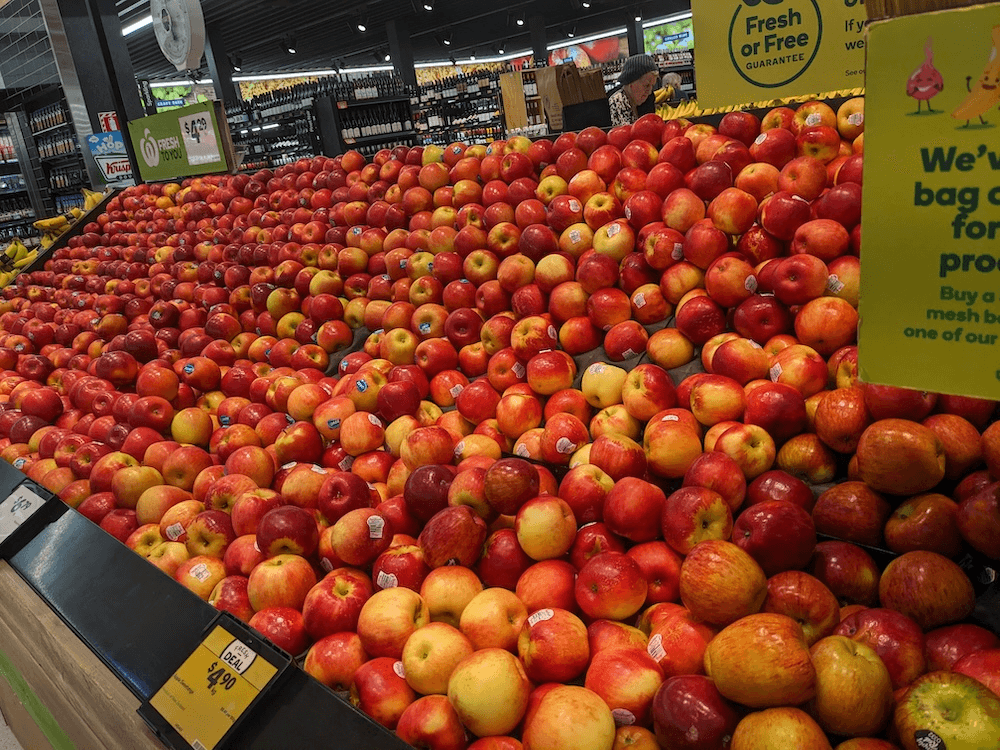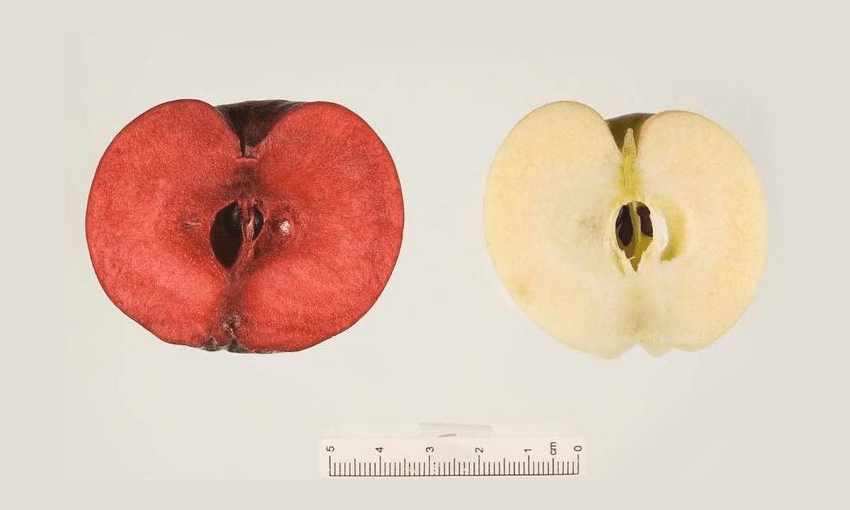What's behind the explosion of apple varieties at the supermarket?
Apples are available year-round, but the wide variety on offer involves intensive scientific research – and large-scale commercialisation.

What’s beautiful, red, sweet and crunchy? Tony Martin’s favourite kind of apple: Sassy. The CEO of apple and pear breeding organisation Prevar, Martin’s fondness for Sassy represents professional success as well as personal preference.
Sassy comes complete with a snazzy website (sample marketing copy: “a pleasant balance of sweet zing and a mild after-taste”) and trademarked name. But given the fruit is not widely available to the public yet, it’s slightly unfair of Martin to wax lyrical to a journalist who didn’t have enough breakfast.
New Zealand is a world leader in apples: about 80% of our crop is exported. Mainly grown in Hawkes Bay and Nelson, the industry is incredibly valuable. Last season, the apple exports from the port of Napier were valued at $61 million, which is about two thirds of the total crop. Karen Morrish, the CEO of Apples and Pears New Zealand, says that this year’s crop is estimated to be about 21 million cartons, 18kg each.
Nestled tightly and safely into boxes, then loaded into ships that keep them cool, this bounty of apples mainly goes to Asia, where apples from Aotearoa can command a premium. The shift to exporting is one of the reasons varieties have changed, because Asian customers prefer sweeter, redder fruit, rather than tarter and greener traditional apples.
“Red and Golden Delicious, those are still grown, but much less,” says Ryan McMullen, Woolworths New Zealand’s head of produce. Out of the hundreds and hundreds of apple varieties out there, he’s one of the people who decides which ones make it into the apple shelves at your local supermarket – which look quite different to a couple of decades ago. “When I was younger, my favourite apple was a Splendour, but you’d struggle to find that now,” McMullen says. These days, he likes sweeter varieties, like Sweetango and Pacific Rose.
In both Woolworths and Foodstuffs supermarkets, one apple variety reigns supreme: the appropriately named Royal Gala, red with yellow streaks. McMullen says the variety is also responsible for Jazz apples, which are a cross between Royal Gala and Braeburn; mottled and easily fitting in a palm. Initially bred in 1984, it took nearly two decades until Jazz apples became widely available in the early 2000s – a pretty standard timeline. Developed in New Zealand, Jazz apples are now grown around the world.
“You need to cross a few apple varieties, wait a year to see how it performs, if it isn’t right you cross it again,” Martin explains. The process is iterative; and once the variety, called a cultivar, is producing consistent results, it has to be scaled up by growers grafting it onto their rootstock. This means Prevar is trying to develop varieties that people will buy, but the varieties also need to appeal to growers, because adding a new variety to a pip fruit orchard is a significant financial commitment. Is there a desire for an early or late season apple, so all the fruit aren’t ripe at the same time? Is there a need for more productive trees?

Creating a new apple variety “definitely involves people in white lab coats,” Martin says. But the research process is also organic, because even the highest tech apple is still a plant which needs sunshine and earth and water to grow. The research block has hundreds of different trees at different stages and sizes: wee seedlings protected in glass houses, young trees being trained to grow flat like grapevines, older trees adorned with baubles of ripe round fruit. “There are all shapes and colours and flavours, like walking into Willy Wonka’s factory if it was full of apples,” he says.
This image is entirely delightful, but there’s a flip side to this explosion in the commercial possibility of apple varieties. When I ask Martin about this, it’s difficult to remember that he’s talking about apples at all. “We protect our intellectual property, so if anyone wants to grow [a variety] they have to do so through a licensed supplier,” he says. “You protect the variety to capture value – if you give it away there isn’t value to be captured.” There’s also brands to protect – that’s why apple varieties have their own websites and their names are trademarked. “Sassy, Dazzle, Rockit, there is value in the brand.”
Apples don’t grow true to seed, which advantages breeding organisations like Prevar (a joint venture between New Zealand Apples and Pears and Plant and Food Research). If you just had the most delicious apple you’ve ever eaten and then chucked it into the ground and nurtured it, you wouldn’t have any guarantee that the fruit it started producing a few years later would taste anything at all like the original. “You can’t just copy the fruit from a core,” Martin says; breeding restrictions are essential Turnitin for the fruit, and there was an outcry in 2000 when growers in Chile were found to be producing unlicensed Pacific Rose and Southern Snap apples.
Older heritage apples can also be lost, or at least become difficult to find for sale. Morrish, the Apples and Pears boss, has memories of sinking her teeth into juicy Cox’s Orange apples fresh off the tree during her childhood in the UK. “You’d struggle to find those now,“ she says without regret. “Apple varieties now are more scientifically developed, it’s been fantastic for innovation.”
Royal Gala apples grown in a Plant & Food Research greenhouse. Left, Fruit with an additional apple gene to make it red throughout. (Photo: Plant and Food Research)Even Braeburn apples, which are nearly as popular as Royal Gala in the South Island, are becoming less frequently stocked in supermarkets. “We want to bring in a new variety every year or so,” McMullen says. His team are currently looking into the Cosmic Crisp apple, which might be in supermarkets soon. “But that means that some of those older favourites, dropping off, Cox’s Orange, Braeburns etc. But if customers want them and buy them then we’ll keep stocking them, and growers will keep growing them.”
These traditional varieties hold up less well to cool storage, a reality of modern apple consumption. When you’re used to apples piled as hundreds of shiny orbs in the supermarket, it’s easy to forget that they’re seasonal fruit. Right now, early autumn, is peak apple season: the trees have been sucking up sunlight and water all summer and turning them into clusters of sugar. To stop apples getting soft, they’re put into what are essentially giant fridges. “It presses pause on them maturing,” Morrish explains. “It’s possible to pick an apple in April and sell it in November. The apple shortage reported at the end of this summer was because of a small gap in the supply of cool storage, just before the new season’s apples came in."
“Red and Golden Delicious are good-looking apples but they go soft – they’re delicious off the tree but they don’t keep long," Martin says. "Apples these days spend more time getting from A to B, so we need varieties that can be looked after and stored and still eaten 12 months later, so you can eat apples all year around."
I ask him if he has any expectations for the future of the apple industry, and the presumably delicious varieties that haven’t come to market yet. But apples aren’t the only fruit Prevar is developing, and the explosion in science and diversity seen in apples might soon be coming to the next most popular pip fruit. “Pears are pretty exciting,” Martin muses. “There are lots of opportunities for innovation – to help people fall back in love with pears.”











































